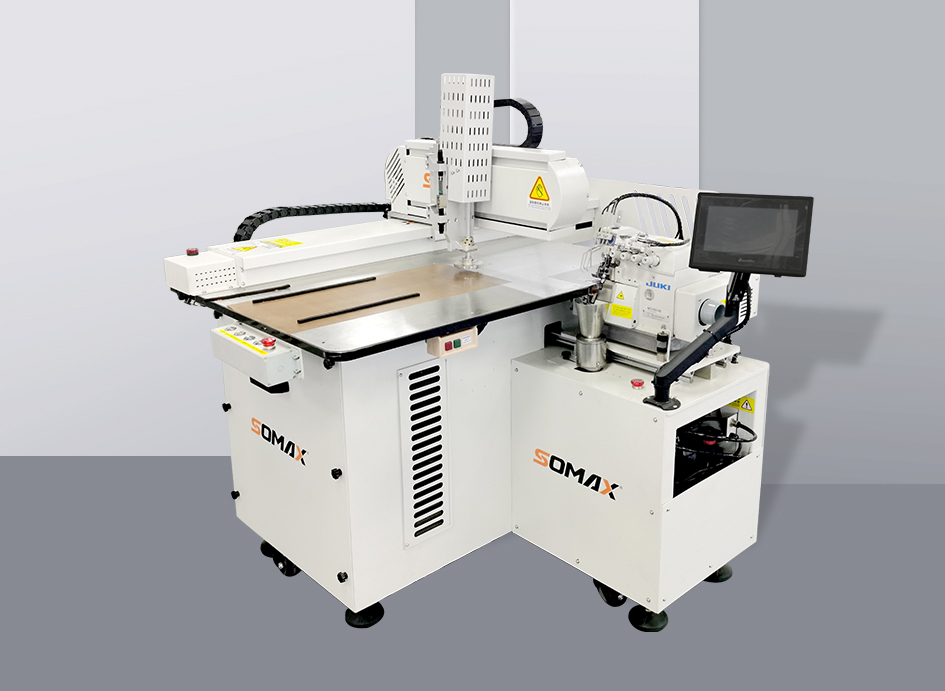
I. Control mode and intelligence
Ordinary overlock sewing machine: rely on manual operation, need to manually adjust the needle distance, stitch tension, thread cutting and other functions, parameter Settings need manual intervention, high skill requirements for the operator.
Automatic overlock sewing machine: integrated numerical control system (such as PLC or computer control system), can be preset needle distance, tension, trimming parameters adjustment, support simple operation can switch different stitch mode (such as three-thread, four-thread sewing),fabric thickness can be easily adjusted.
II. Function and efficiency
Ordinary overlock sewing machine: The basic functions are single, such as threading, thread cutting, and adjusting the presser foot need to be completed by manually. Auxiliary processes (such as fabric feeding and thread cutting) rely on manual operation, and the production efficiency is very low.
Automatic overlock sewing machine: Some models needs automatic loading, feeding, sewing, cutting, and collecting functions (such as SOMAX automatic overlock template machine). There is an integrated servo motor to achieve high-speed and stable sewing. Free skilled operator on the whole process.
III. Precision and consistency
Ordinary overlock sewing machine: stitch uniformity depends on the worker's experience, prone to problems such as needle pitch deviation and skipped stitches, and high defective rate (about 3%-5%).
Automatic overlock sewing machine: The CNC system accurately controls the movement trajectory, with high stitch consistency (error <0.1mm), and the defective rate can be reduced to less than 1%, which is suitable for high-end clothing with strict quality requirements (such as underwear and sportswear)
IV. Operation difficulty and labor cost
Ordinary overlock sewing machine: requires professional workers to operate, long training period (1-3 months), high labor cost (depends on skilled workers).
Automatic overlock sewing machine: simplified interface (touch screen operation), novices can get started after short-term training (1-2 weeks), reducing dependence on skilled workers, and reducing labor costs by 30%-50%.
V. Applicable Scenarios
Ordinary overlock sewing Machine: Suitable for small-batch customization, home workshops, or cost-sensitive low-end markets (such as workwear and home textiles).
Automatic overlock sewing Machine: Ideal for garment factories, clothing production lines, and other large-scale production scenarios, especially for fast fashion and branded clothing with large-volume orders, balancing efficiency and quality.
Core Advantages Comparison
|
Dimension |
Ordinary Overlock Sewing Machine |
Automatic Overlock Sewing Machine |
|
Efficiency |
Low (High manual intervention) |
High (Fully automated with significantly enhanced speed) |
|
Precision |
Human-dependent, inconsistent |
CNC-controlled, high consistency |
|
Labor Cost |
High (Requires skilled workers) |
Low (Simple operation, short training cycle) |
|
Smart Features |
No integration, purely mechanical |
Supports program presets & data monitoring |
|
Applicable Scenarios |
Small workshops, low-end markets |
Factory assembly lines, premium brand production |
Case reference (Quanzhou)
Quanzhou as textile and garments base, a lot of enterprises for instance Septwolves and XTEP have updated their automatic overlock sewing equipment. According to industry data, automatic equipment will increase the avenue capacity by 40%,lower the labor cost by 60%.Especially suitable for sportswear high frequency and accurately edge binding, for example shoes tongue, T-shirts overlock.